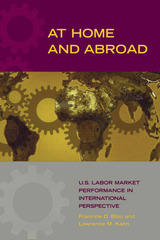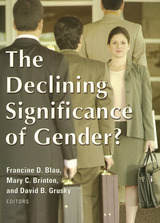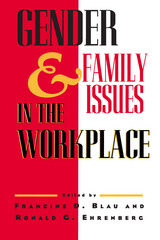3 books about Blau, Francine D.

At Home and Abroad
U.S. Labor Market Performance in International Perspective
Francine D. Blau
Russell Sage Foundation, 2002
Throughout the latter part of the 20th century, the U.S. labor market performed differently than the labor markets of the world's other advanced industrialized societies. In the early 1970s, the United States had higher unemployment rates than its Western European counterparts. But after two oil crises, rapid technological change, and globalization rocked the world's economies, unemployment fell in the United States, while increasing dramatically in other nations. At the same time, wage inequality widened more in the United States than in Europe. In At Home and Abroad, Cornell University economists Francine D. Blau and Lawrence M. Kahn examine the reasons for these striking dissimilarities between the United States and its economic allies. Comparing countries, the authors find that governments and unions play a far greater role in the labor market in Europe than they do in the United States. It is much more difficult to lay off workers in Europe than in the United States, unemployment insurance is more generous in Europe, and many fewer Americans than Europeans are covered by collective bargaining agreements. Interventionist labor market institutions in Europe compress wages, thus contributing to the lower levels of wage inequality in the European Union than in the United States. Using a unique blend of microeconomic and microeconomic analyses, the authors assess how these differences affect wage and unemployment levels. In a lucid narrative, they present ample evidence that, as upheavals shook the global economy, the flexible U.S. market let wages adjust so that jobs could be maintained, while more rigid European economies maintained wages at the cost of losing jobs. By helping readers understand the relationship between different economic responses and outcomes, At Home and Abroad makes an invaluable contribution to the continuing debate about the role institutions can and should play in creating jobs and maintaining living standards.
[more]

The Declining Significance of Gender?
Francine D. Blau
Russell Sage Foundation, 2006
The last half-century has witnessed substantial change in the opportunities and rewards available to men and women in the workplace. While the gender pay gap narrowed and female labor force participation rose dramatically in recent decades, some dimensions of gender inequality—most notably the division of labor in the family—have been more resistant to change, or have changed more slowly in recent years than in the past. These trends suggest that one of two possible futures could lie ahead: an optimistic scenario in which gender inequalities continue to erode, or a pessimistic scenario where contemporary institutional arrangements persevere and the gender revolution stalls. In The Declining Significance of Gender?, editors Francine Blau, Mary Brinton, and David Grusky bring together top gender scholars in sociology and economics to make sense of the recent changes in gender inequality, and to judge whether the optimistic or pessimistic view better depicts the prospects and bottlenecks that lie ahead. It examines the economic, organizational, political, and cultural forces that have changed the status of women and men in the labor market. The contributors examine the economic assumption that discrimination in hiring is economically inefficient and will be weeded out eventually by market competition. They explore the effect that family-family organizational policies have had in drawing women into the workplace and giving them even footing in the organizational hierarchy. Several chapters ask whether political interventions might reduce or increase gender inequality, and others discuss whether a social ethos favoring egalitarianism is working to overcome generations of discriminatory treatment against women. Although there is much rhetoric about the future of gender inequality, The Declining Significance of Gender? provides a sustained attempt to consider analytically the forces that are shaping the gender revolution. Its wide-ranging analysis of contemporary gender disparities will stimulate readers to think more deeply and in new ways about the extent to which gender remains a major fault line of inequality.
[more]

Gender and Family Issues in the Workplace
Francine D. Blau
Russell Sage Foundation, 1997
Today, as married women commonly pursue careers outside the home, concerns about their ability to achieve equal footing with men without sacrificing the needs of their families trouble policymakers and economists alike. In 1993 federal legislation was passed that required most firms to provide unpaid maternity leave for up to twelve weeks. Yet, as Gender and Family Issues in the Workplace reveals, motherhood remains a primary obstacle to women's economic success. This volume offers fascinating and provocative new analyses of women's status in the labor market, as it explores the debate surrounding parental leave: Do policies that mandate extended leave protect jobs and promote child welfare, or do they sidetrack women's careers and make them less desirable employees? An examination of the disadvantages that women—particularly young mothers—face in today's workplace sets the stage for the debate. Claudia Goldin presents evidence that female college graduates are rarely able to balance motherhood with career track employment, and Jane Waldfogel demonstrates that having children results in substantially lower wages for women. The long hours demanded by managerial and other high powered professions further penalize women who in many cases still bear primary responsibility for their homes and children. Do parental leave policies improve the situation for women? Gender and Family Issues in the Workplace offers a variety of perspectives on this important question. Some propose that mandated leave improves women's wages by allowing them to preserve their job tenure. Other economists express concern that federal leave policies prevent firms and their workers from acting on their own particular needs and constraints, while others argue that because such policies improve the well-being of children they are necessary to society as a whole. Olivia Mitchell finds that although the availability of unpaid parental leave has sharply increased, only a tiny percentage of workers have access to paid leave or child care assistance. Others caution that the current design of family-friendly policies may promote gender inequality by reinforcing the traditional division of labor within families. Parental leave policy is a complex issue embedded in a tangle of economic and social institutions. Gender and Family Issues in the Workplace offers an innovative and up-to-date investigation into women's chances for success and equality in the modern economy.
[more]
READERS
Browse our collection.
PUBLISHERS
See BiblioVault's publisher services.
STUDENT SERVICES
Files for college accessibility offices.
UChicago Accessibility Resources
home | accessibility | search | about | contact us
BiblioVault ® 2001 - 2024
The University of Chicago Press









